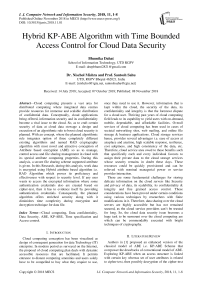Hybrid KP-ABE algorithm with time bounded access control for cloud data security
Автор: Bhumika Dahat, Nischol Mishra, Santosh Sahu
Журнал: International Journal of Computer Network and Information Security @ijcnis
Статья в выпуске: 11 vol.10, 2018 года.
Бесплатный доступ
Cloud computing presents a vast area for distributed computing where integrated data centres provide resources for immense and scalable distribution of confidential data. Conceptually, cloud applications being offered, information security and its confidentiality become a vital issue to the cloud. So, as to craft certain security of data at cloud data stowage a design and execution of an algorithmic rule to boost cloud security is planned. With an concept, where the planned algorithmic rule integrates option of three completely different existing algorithms and named RAD cryptography algorithm with most novel and attractive conception of Attribute based encryption (ABE) so as to manage, control access and file sharing management in cloud with its special attribute computing properties. During this analysis, a secure file sharing scheme supported attribute is given. In this Research, during this analysis, work data is encrypted using Hybrid attribute based algorithm i.e. RAD Algorithm which proves its proficiency and effectiveness with respect to security level. If any user wants to access the encrypted information where some authentication credentials also are created based on cipher-text, then it has to evidence itself by providing authentication credentials. Consequently, the planned algorithm offers enriched security along with it diminishes time complexity during encryption and decryption technique for data file.
Cloud computing, Data confidentiality, Data Security, ABE, KP-ABE, Time specification and Access control
Короткий адрес: https://sciup.org/15015642
IDR: 15015642 | DOI: 10.5815/ijcnis.2018.11.01
Текст научной статьи Hybrid KP-ABE algorithm with time bounded access control for cloud data security
Published Online November 2018 in MECS DOI: 10.5815/ijcnis.2018.11.01
-
II. Literature Review
However, in [6,10] authors have expressed effective outsourcing method for decryption of KP-ABE ciphertext and ABE chosen cipher-text security and in [7,11,12] predefined outsourcing scheme has been enhanced with check ability mechanism and verifying the decryption process of the schemes and outsourced data security has also been proved by the authors. Therefore authors in [3] explained the improved version of outsourcing CP-ABE scheme by providing well-organized verification mechanism where they had used blinding algorithm for the decrement of number of exponential setups in the encryption to a constant. Thus, they have assured the check ability for reassurance of the accuracy of their scheme.
Authors in [17] had reviewed and made evaluation with comparison of two significant security techniques i.e. Cryptography and steganography. In [19] Authors in their theory presented novel Secure Transmission of data through DNA cryptographic system using Symmetric encryption algorithm by using two step security encryption algorithm. According to [18], authors have analysed the techniques summing up the classical encryption algorithm procedures with DNA encryption process and clarified how it can be applicable in real world while facing certain challenges. They have summarized DNA computing with each and every conventional cryptographic encryption algorithm. In [26], they proposed a hybrid structure based on Public key cryptography mixing it with DNA cryptography and Digital Signature concept. They further defined the two key pair uses for encryption and decryption algorithm and respectively signature. Thus in [25], the Authors have represented an integrated method to enrich the Symmetric Key Cryptography by using the robust feature of DNA computation in which a novel procedure to twofold the key generation for encryption and decryption process has been introduced.
-
III. Problem Formulation
In Cloud computing region, the fundamental difficulties are related to cloud data security, data confidentiality, privacy preservation and data backup storage into cloud. As cloud computing facilitates enhances features of security infrastructure where essentially cloud can store immense amount of information and expressively run infinite applications using various security methods but there are huge risks of escaping data from cloud servers during sharing and transmission of data. Therefore, in previous literatures they proved security of their schemas but the techniques are much time consuming and possess inflexible complexities. Consequently, to overpower the problems related to data confidentiality, security and its integrity with fine grained access control of outsourced information and enlighten issues of complexity and time control cloud based cryptographic approach is intended and jumbled up to acquire and ensure superior security of cloud data.
-
IV. Proposed Methodology
A. Flowchart of Proposed Model
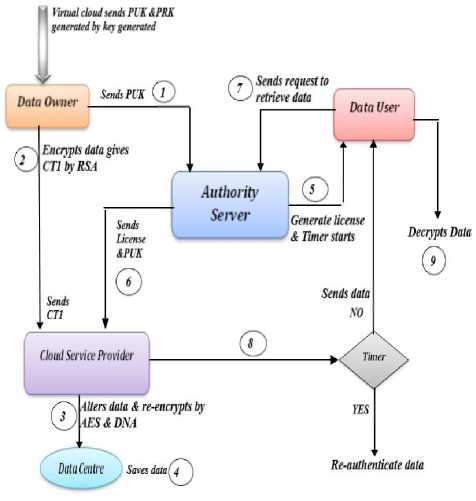
Fig.1. Flowchart of Proposed Scheme
According to Fig:1 the steps of flowchart are as follows:
Step (1): Key Generator into Cloud server - CS generates keys in cloud environment and it distributes PUK (public key) and PRK (private key) to cloud users and only PUK to Data owner.
Step (2): Data Owner -- Then data owner by his PRK generates SK (secret key) with RSA algorithm and encipher it and transfers the encrypted data CT1 to CSP.
Step (3): Cloud Service Provider -- CSP thus alters the enciphered cipher-text, re-encrypts it into another cipher CT2 by combining AES algorithm and DNA algorithm into final cipher-text CT3 forming a complicated message.
Step (4): Data Centre - Then, the data send by the data owner to the CSP is saved into Data centre.
Step (5), (6): Authority Server (Third Party) — Hence, Authority Server generates the license for data user and after generation of license he sends it to CSP with PUK and then timer starts running.
Step (7): Data User - Thereafter, Data user sends a request for retrieval of data from authority server and unless until he gets permission to retrieve by satisfying his authentication, end user cannot decrypt it.
Step (8), (9): CSP and Timer Expires -- When the data user credentials are satisfied i.e. after authentication time specific licence is provided to the end user for accessing data files of owner, i.e. CSP provides encrypted data to the data end user and it generates two conditions; if Timers gives NO condition then data end user has authenticated himself as an authorised user and has time to decrypt data in that interval of time and if Timers YES condition comes, then it seems that user had not decrypted the data in a certain time interval and data is self-destructed.
-
B. Algorithm of Proposed Work (Amalgam RAD Algorithm)
(Notations: n = integers (big no.), e = encryption of a function, d = decryption of a function, ϕ = function of n (integers), ∏= (threshold time, ta<∏ M= plaintext, C1׳ =Encrypted Cipher-text by RSA, C2׳= encrypted cipher-text by AES, C3׳= encrypted cipher-text by DNA], λ = attribute parameters (U_Id= user ID, O_Id= Owner ID, F_Id= File Id, Date, R_ID= receiver Id), U1 =data owner, U2 =data end user, CS = Cloud Server, CSP = cloud service provider, PRK= Private Key, PUK= Public Key, SK = Secret Key, AS= Authority server.) (1) SETUP PHASE: CS generates PUK & PRK into a cloud environment. (2) KEY GENERATION PHASE: ( i) Generated PUK = {X, A1, A2, A3…..An} ( ii) Generated PRK = {x, a1, a2, a3… an} ■ Select two prime numbers M and N such that M ≠ N and determine σ= M*N(1) ■ Calculate ф= (M-1)(N-1)(2) ■ Find PUK and PRK suchthat PUK = PRK-1 [mod ф](3) ■ Where PRK = gcf [ф, PRK] =1(4) {1< PRK< ϕ} ■ SK = (X, PRK)(5) {⸫ λ = attribute parameters (U_Id, O_Id, F_Id, Date)} (3) ENCRYPTION PHASE: Step-(I) Cipher (byte Msg, byte C1׳) begin { C1' = MsgPRK mod т (6) end } Step-(II) //C1׳ and C2׳ are byte arrays which are assumed to be input data and output ciphered data respectively. // position [] is a 2-dimensional array holding bytes in 8 rows and 8 columns. //roundSeckey[] is an array holding the SK for algorithm round. //RoundSecKey(), Sub_Bytes(), Shift_Rows(), and Mix_Columns() are functions representing the discrete alterations. And its Inv. those are converse functions.) Cipher (byte C1׳, int SK, byte C2׳, key-array roundSeckey(N+1)) begin byte position [32]; position= C1׳; { Add RoundSecKey(position, roundSeckey[0]); for l = 1 to N-1 stepsize 1 do Sub_Bytes(position); Shift_Rows (position); Mix_Columns (position); Add RoundSecKey (position, roundSeckey[l]); end for Sub_Bytes (position); Shift_Rows (position); Add RoundSecKey (position, roundSeckey[N]); C2׳ = position; end } Step-(III) Cipher (byte C2׳, byte C3׳) state = C2׳; begin { convert ASCII code(state); convert binary code(state); pairing(state); DNA digital coding(state); DNA sequencing(state); C3׳ = DNA sequencing(state); end } (4) AUTHENTICATION PHASE: U2 (Ц) ^ AS {X2= Data attributes (O_Id, F_Id, R_Id) if (λ2 = = λ1) satisfies {λ1 =Attributes (U_Id, F_Id, date) then go to decryption phases; else exit. (5) DECRYPTION PHASE: Step-(I) Decipher (byte C3׳, byte C2׳) State = C3׳; begin { DNA op.sequencing(state) {op.sequencing applied for opposite DNA sequencing} DNA_digital.decoding(state); convert binary code(state); Convert ASCII(state); C2׳ = convert byte(state); end } Step-(II) Decipher (byte C2׳, byte C1׳, round Seckey (N+1)) begin byte position [32] ; position = C2׳ { for l = 1 to N-1 stepsize 1 do Inv_Shift_Row (position); Inv_Sub_Bytes (position); Inv_Mix_Column(position); end for Add RoundSecKey (position, roundSeckey[l]); Inv_Shift_Rows (position); Inv_Sub_Bytes (position); Inv Add RoundSecKey (position, roundSeckey[0]); C1׳= position; end } Step-(III) Decipher (byte C1׳, Msg) begin { Msg = C1'PUK mod. a; (7) end } Step-(IV) If d [C2׳, C1׳, Msg] < ∏ {decryption satisfies threshold time interval ta < ∏ < tb} then download Msg; else; Msg destroyed, exit. V. Implmentation and Performance Analysis First of all, the cloud atmosphere is created using cloudsim. The proposed work has simulated in the cloud environment with two data center having two data user. Here, one of the users is the data owner i.e. whose data file is stored at the cloud server and other data user is the receiver who desires to access the data file of the owner. After generation of cloud surroundings, the key generator of cloud server generates public and private key and provide it to both data owner and end user. But, as such data owner is responsible for further encryption of data owner sends only his public key to the cloud authority server (CAS) for further decryption process. Simultaneously, when data owner wants to save data file at the data centre then he firstly generates the secret key by Algorithm-step-I (Encryption) of RAD algorithm using User Id/ Owner Id, File Id and Date as attributes of the file. After secret key generation, the cloud service provider encrypts the data file using the generated secret key using step-II and step-III of RAD algorithm. After encryption CSP (Cloud Service Provider) handover the encrypted data to cloud data center for further uploading the file. Whenever any cloud end user needs to access the data file of the data owner, then it has to authenticate himself by providing authentication credentials in a given time interval i.e. File Id, Receiver’s Id and Owner’s Id. If all the authentication credentials matches, then only the data user is provided authentication rights to access the data file stored at data center in encrypted form. Otherwise, data end user is declared as unauthorized user. After authentication of the user, CAS provides the public key of data owner and secret key to the data user so as to retrieve file from the data server/ data center. Therefore, when a user gets decryption keys a timestamp is started for the ḍecryption of data for end data user to access or retrieve the data file from the data center. If the data is decrypted with specific license in the predefined time interval then data could be accessed by end user otherwise the data is destroyed and the end user has to reauthenticate himself. VI. Evaluation of Execution Time In Table:1, the execution time analysis has been computed of the proposed method that explains the Key Generation time analysis, Encryption time analysis and Decryption time analysis of various different types ofdata file size. Therefore it has been evaluated that as the file size increases the key generation time, encryption time and decryption time increases gradually. Table 1. Computational Time Analysis S. No. File Size Key Generation Time (in ms) Encryption Time(in ms) Decryption Time (in ms) 1. 10MB 4 24 4 2. 15MB 5 25 4 3. 20MB 5 25 4 4. 60MB 6 26 10 5. 120MB 8 37 12 Then in Fig: 2 the key generation time has been examined graphically where from 10MB to 15MB the graph take a speed gradually but remain constant between 15MB to 20MB and then again gradually increases accordingly with the file size. Key_Generation Time (in ms) Fig.2. Key Generation Time Analysis Fig.3. Encryption Time Analysis Therefore in Fig: 3 the encryption time has been evaluated. Here, initially the from 10MB to 15MB there minor increment and from 15MB to 20MB the graph remains constant and slightly increases to 60 MB and then suddenly increases up to 120 MB according to file size. Hence, Fig:4 shows decryption time analysis where the graph remains constant from 10MB to 20 MB and gradually increases from 20MB to 120 MB. A. Comparative Analysis The Presented proposed model is therefore equated with previous paper [30] and by analysing it is found that our proposed arrangement is quite less time consuming, reliable, cost effective and proficient as compared for encryption time and decryption time of various sorts of data sizes ranges from 100KB to 50MB (i.e. 100KB, 500KB, 1MB, 2MB, 5MB, 10MB and 50MB). As the consumed time period for both encryption phase and decryption phase is calculated by following Formula: Time consumption = Execution stop time – Execution start time Thus, in Table:2 the comparative analysis for proposed and existing times of encryption and decryption has been shown in mili-seconds. Hence, after observing the comparison of both existing and proposed technique, it can be assessed that as for encryption, time fluctuates i.e. decreases and increases gradually as increase in the file size and for the decryption, time increases gradually as the data size increases. And, in Fig:5 and Fig:6 the observations of encryption and decryption time of proposed method has been compared with existing system [30] in the same files size range from 100 KB to 50 MB which shows the huge difference. Table 2. Comparative Analysis of Proposed Method Fig.6. Decryption Time Comparison VII. Conclusion Exploration of presented work is concentrated on cloud information security at cloud end. To create solid data protection of cloud data repository at cloud end, the fortified architecture is designed that secures and shield the data using encryption/decryption algorithm where the proposed algorithm is a hybrid encryption algorithm that uses the concept of CSP (Cloud service Provider) and CAS (Cloud Authority Server). The technique Key policy attribute based encryption is used with hybrid technique of RSA, AES and DNA cryptography algorithm which is executed in the planned methodology for the access of encrypted cloud data which created an well-organized system in terms of execution time and security as compared to the existing methods of cloud data retrieval. Therefore, fruitful results are produced by the implementation of proposed methodology. Tested outcomes indicate that the projected idea is affordable; its improved potency in terms of execution time, security and providing confidentiality of cloud data at cloud end is quite rational. Also, the re-encrypting of data three times before sharing and transmitting to cloud end users provides a tough key that could hardly be cracked for its accession. This technique is applied differently in this method with time that reduces the encryption and decryption time as compared which create uniqueness in it. This effort of research also uses the concept of authentication of the user. The planned method provides a sheltered framework for confidentiality of text information at cloud data stowage which will be beneficial in an exceedingly range of applications at cloud end. Simplicity and confidentiality are the inclusions in the advantage of the planned methodology. Therefore, outcome analysis illustrates that this technique takes less computational time and hence overall cost is less. Although, in terms of security and retrieval rate and computational time the well-organized technique has been implemented here shows novelty, but further enrichments may be trialled for the communication overhead and latency that may appears during the encrypted data retrieval. Acknowledgement I thank to my respected Guide and Co-guide with all professors who directed me thoroughly in right path for this paper. This work was supported by School of Information Technology University of Teaching Dept. RGPV Bhopal.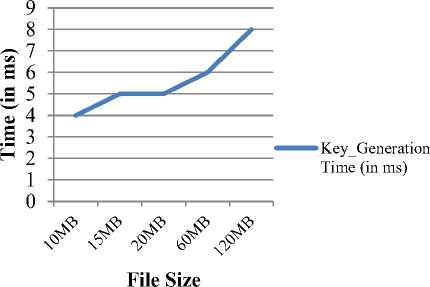
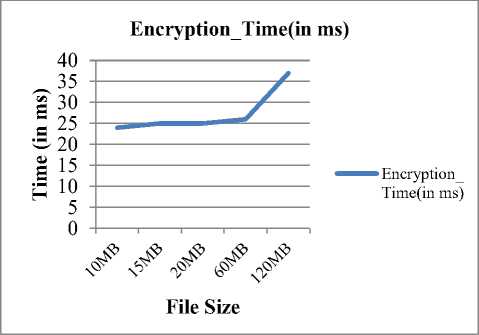
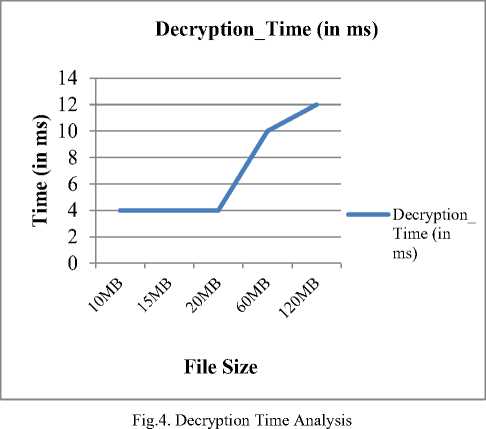
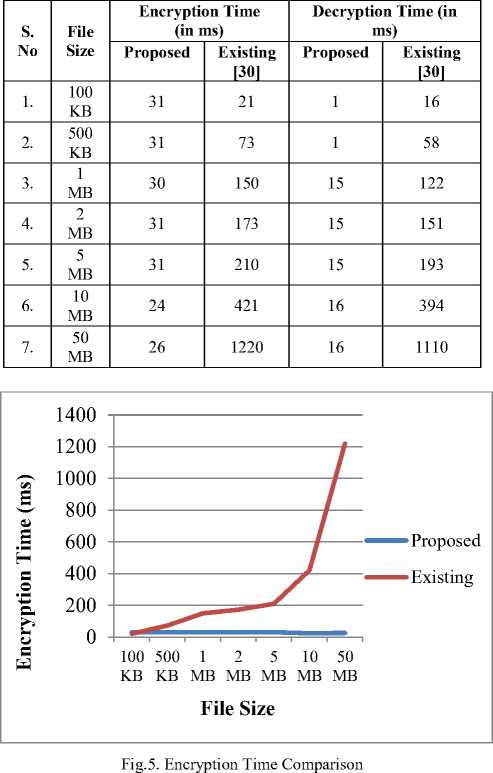
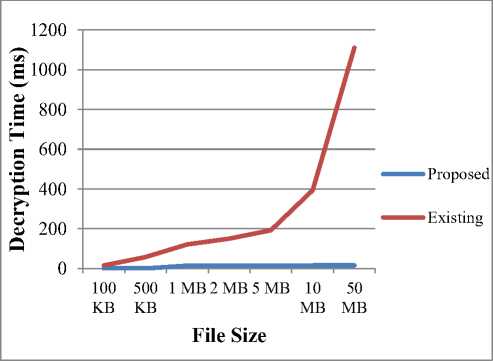
Список литературы Hybrid KP-ABE algorithm with time bounded access control for cloud data security
- Goyal V, Pandey O, Sahai A, Waters B (2006) “Attribute-based encryption for ?ne-grained access control of encrypted data”. In: Proceedings of the 13th ACM conference on computer and communications security.
- Ma J, Lai J, Deng R H, Ding X (2016) “Adaptable key-policy attribute based encryption with time interval.”
- Jing L, Xiong L, Licheng W ,Debiao H, Haseeb A, Xinxin N(2017) “Fuzzy encryption in cloud computation: efficient verifiable outsourced attribute-based encryption”.
- Lai J, Deng RH, Yang Y, Weng J (2013) “Adaptable cipher-text policy attribute-based encryption”. In: Pairing-based cryptography— pairing 2013. Springer.
- Paterson KG, Quaglia EA (2010) “Time-specific encryption”. In: Garay JA, De Prisco R (eds) Security and cryptography for networks. Springer, Berlin.
- Green M, Hohenberger S, Waters B (2011) “Outsourcing the decryption of ABE cipher text”.
- Huang X, Li J, Li J (2014) “Securely outsourcing attribute-based encryption with check ability”. Transactions on Parallel and Distributed Systems, Vol. 25, No. 8.
- Xhafa F, Wang J, Chen X (2014)” An ef?cient PHR service system supporting fuzzy keyword search and ?ne-grained access control”.
- Nuttapong Attrapadung, Benoit Libert, and Elie de Pana?eu(2008)” Expressive Key-Policy Attribute-Based Encryption with Constant-Size Cipher text”.
- Chao Li, Bo Lang and Jinmiao Wang(2014) “Outsourced KP-ABE with chosen cipher-text security”.
- J. Li, X. Chen, J. Li, C. Jia, J. Ma, and W. Lou, “Fine-grained access control system based on outsourced attribute-based encryption,” in Computer Security–ESORICS 2013. Springer, 2013.
- J. Lai, R. H. Deng, C. Guan, and J. Weng, “Attribute-based encryption with veri?able outsourced decryption,” Information Forensics and Security, IEEE Transactions (2013).
- Rivest RL, Shamir A, Wagner D A (1996) “Time-lock puzzles and timed release- cryptography.
- Bethencourt, J., Sahai, A., Waters, B.: Ciphertext-policy attribute-based encryption. In: IEEE Symposium on Security and Privacy, (2007).
- Goyal, V., Jain, A., Pandey, O., Sahai, A. “Bounded Ciphertext Policy Attribute Based Encryption”. In: Aceto, L., Damg?ard, I. Goldberg, L.A., Ing′olfsd′ottir, A., Walukiewicz, I. (eds.) ICALP 2008.
- Tysowski, P.K., Hasan, M.A.: Hybrid Attribute-Based Encryption and Re-Encryption for Scalable Mobile Applications in Clouds. Technical Report 13, Centre for Applied Cryptographic Research (CACR), University of Waterloo (2013).
- “A Survey On Recent Approaches Combining Cryptography And Steganography” David C. Wayld et al: Computer Science & Information Technology (CS & IT), SIP, CST, ARIA, NLP – 2017 pp. 63– 74.
- Anurag Roy, Ashoke Nath “DNA Encryption Algorithm –Scopes And Challenges in Symmetric Key Cryptography” International Journal of Innovative Research in Advanced Engineering (IJIRAE) Volume 3 (November 2016).
- Bonny B. Raj, J. Frank Vijay, T. Mahalakshmi “Secure Data Transfer through DNA Cryptography using Symmetric Algorithm” International Journal of Computer Applications (0975 – 8887) Volume 133 – No.2, January 2016.
- Gritti, C., Susilo, W., Plantard, T. & Win, K. (2015). Privacy-preserving encryption scheme using DNA parentage test. Theoretical Computer Science,
- Anupriya Aggarwal & Praveen Kanth “Secure Data Transmission Using DNA Encryption” IOSR Journal of Computer Engineering (IOSR-JCE) Volume 16, Issue 2, Ver. II (Mar-Apr. 2014).
- A Fatma E. Ibrahim. M. I. Moussa, H. M. Abdalkader “Symmetric Encryption Algorithm based on DNA Computing” International Journal of Computer Applications (Volume 97 No.16, July 2014.
- Jaspal Kaur Saini and Harsh K Verma “A Hybrid Approach for Image Security by Combining Encryption and Steganography” Proceedings of IEEE 2013 Second International Conference on Image Information Processing.
- Ronak Doshi, Pratik Jain, Lalit Gupta “Steganography and its Applications in Security” International Journal of Modern Engineering Research (IJMER) Vol.2, Issue.6, Nov-Dec. 2012 pp-4634-4638.
- Bibhash Roy, Gautam Rakshit, Pratim Singha, Atanu Majumder, Debabrata Datta “An improved Symmetric key cryptography with DNA based strong cipher” IEEE Device and Communication (ICDeCom) 2011 International Conference.
- Lai X J, Lu M X, Qin L, et al.“Asymmetric encryption and signature method with DNA technology.” Science China Press and Springer-Verlag Berlin Heidelberg 2010.
- Adleman L. “Molecular computation of solutions to combinatorial problems”. Science, 1994.
- Dan Boneh, Cristopher Dunworth, and Richard Lipton. "Breaking DES Using a Molecular Computer". Technical Report CS-TR-489-95, Department of Computer Science, Princeton University, USA, 1995.
- Ashish Gehani, Thomas LaBean, and John Reif “DNA-Based Cryptography” A preliminary version appears in DIMACS DNA Based Computers V, American Mathematical Society, 2000.
- Bokhari et.al, Shallal et.al “Evaluation of Hybrid Encryption Technique to Secure Data during Transmission in Cloud Computing” International Journal of Computer Applications volume -166, no.4 May -2017.

